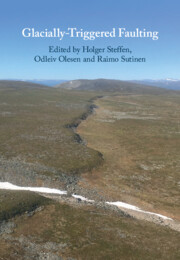Book contents
- Glacially-Triggered Faulting
- Glacially-Triggered Faulting
- Copyright page
- Contents
- Figures
- Tables
- Contributors
- Preface
- Part I Introduction
- Part II Methods and Techniques for Fault Identification and Dating
- Part III Glacially Triggered Faulting in the Fennoscandian Shield
- Part IV Glacially Triggered Faulting at the Edge and in the Periphery of the Fennoscandian Shield
- Part V Glacially Triggered Faulting Outside Europe
- Part VI Modelling of Glacially Induced Faults and Stress
- Part VII Outlook
- 24 Future Research on Glacially Triggered Faulting and Intraplate Seismicity
- Index
- References
24 - Future Research on Glacially Triggered Faulting and Intraplate Seismicity
from Part VII - Outlook
Published online by Cambridge University Press: 02 December 2021
- Glacially-Triggered Faulting
- Glacially-Triggered Faulting
- Copyright page
- Contents
- Figures
- Tables
- Contributors
- Preface
- Part I Introduction
- Part II Methods and Techniques for Fault Identification and Dating
- Part III Glacially Triggered Faulting in the Fennoscandian Shield
- Part IV Glacially Triggered Faulting at the Edge and in the Periphery of the Fennoscandian Shield
- Part V Glacially Triggered Faulting Outside Europe
- Part VI Modelling of Glacially Induced Faults and Stress
- Part VII Outlook
- 24 Future Research on Glacially Triggered Faulting and Intraplate Seismicity
- Index
- References
Summary
This chapter summarizes the book with a focus on the future of glacially triggered faulting research. The concept of glacially triggered faulting is challenged by new results from Fennoscandia documenting several episodes of fault rupture within the past 14,000 years. We speculate that some of these ruptures at known (or potential) glacially induced faults may not be due to glacially triggered faulting but may contain a signature of tectonically driven intraplate seismicity. Glacially triggered faulting cannot be totally ignored though for these episodes, since the ongoing rebound of the lithosphere is continuously increasing glacially induced stresses that can eventually be released under favourable conditions. As those conditions can only be described by a complex 4-dimensional model, simple identification of glacially induced faults is hampered. Precise dating of the younger fault ruptures is especially important to produce the necessary spatiotemporal image. The intended DAFNE drilling and subsequent in situ observations of the Pärvie Fault combined with numerical modelling will contribute to an improved understanding of the fault mechanism.
Keywords
Information
- Type
- Chapter
- Information
- Glacially-Triggered Faulting , pp. 419 - 428Publisher: Cambridge University PressPrint publication year: 2021
References
Accessibility standard: Unknown
- 2
- Cited by
